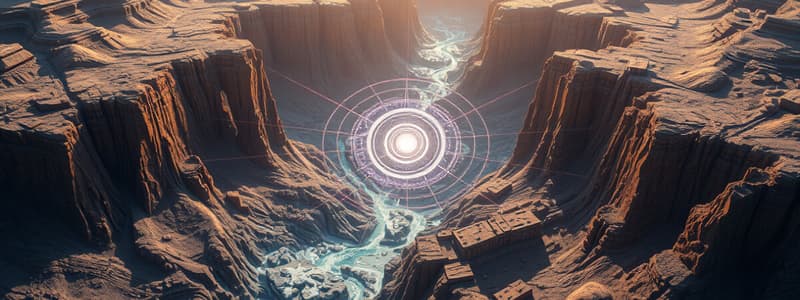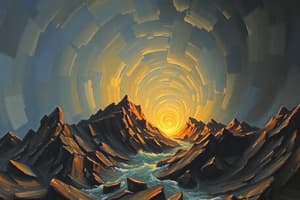Podcast
Questions and Answers
What is the difference between the focus of an earthquake and the epicenter?
What is the difference between the focus of an earthquake and the epicenter?
The focus is the first point of movement along a fault where all earthquake waves originate, below the surface. The epicenter is the point on the surface above the focus.
How can the ground move during an earthquake?
How can the ground move during an earthquake?
In any direction
Small earthquakes that occur before large ones are called __________.
Small earthquakes that occur before large ones are called __________.
foreshocks
What do primary waves do?
What do primary waves do?
What do secondary waves do?
What do secondary waves do?
What type of waves are the most destructive?
What type of waves are the most destructive?
What do primary waves do to the rocks they travel through?
What do primary waves do to the rocks they travel through?
Primary waves can travel through the outer core.
Primary waves can travel through the outer core.
What do secondary waves do to particles?
What do secondary waves do to particles?
How many seismic stations are required to find an epicenter?
How many seismic stations are required to find an epicenter?
List steps to explain how the epicenter of an earthquake is determined.
List steps to explain how the epicenter of an earthquake is determined.
An earthquake's magnitude is determined by the
An earthquake's magnitude is determined by the
How is the distance between an epicenter and a measuring station determined?
How is the distance between an epicenter and a measuring station determined?
What scale is most widely used by scientists for measuring earthquakes?
What scale is most widely used by scientists for measuring earthquakes?
What is the difference between a seismogram and a seismometer?
What is the difference between a seismogram and a seismometer?
What is called the amount of shaking produced by an earthquake at a given location?
What is called the amount of shaking produced by an earthquake at a given location?
Each point on the Richter scale represents a wave amplitude
Each point on the Richter scale represents a wave amplitude
What can affect the amount of destruction caused by earthquakes?
What can affect the amount of destruction caused by earthquakes?
What kind of material is safest to build structures on in an earthquake-prone area?
What kind of material is safest to build structures on in an earthquake-prone area?
What are generated when the ocean floor moves as the result of an earthquake?
What are generated when the ocean floor moves as the result of an earthquake?
When unconsolidated sediments become saturated with water, earthquakes can turn the soil into a fluid in a process called ____.
When unconsolidated sediments become saturated with water, earthquakes can turn the soil into a fluid in a process called ____.
How can earthquakes cause fires?
How can earthquakes cause fires?
How can scientists make short-range predictions of earthquakes?
How can scientists make short-range predictions of earthquakes?
The lithosphere is made of the
The lithosphere is made of the
What is Moho?
What is Moho?
Most of the information about Earth's interior was discovered through the study of
Most of the information about Earth's interior was discovered through the study of
Secondary waves cannot travel through the outer core.
Secondary waves cannot travel through the outer core.
Earth's inner core is solid because of
Earth's inner core is solid because of
Earth's inner and outer core is made of
Earth's inner and outer core is made of
Flashcards are hidden until you start studying
Study Notes
Earthquake Fundamentals
- Focus: The initial point of movement along a fault beneath the Earth's surface, where all earthquake waves originate.
- Epicenter: The location on the Earth's surface directly above the focus, receiving the most intense vibrations during an earthquake.
Ground Movement
- During an earthquake, the ground can move in any direction.
Earthquake Types
- Foreshocks: Smaller earthquakes that precede a major quake.
- Aftershocks: Small earthquakes that follow a major earthquake as the materials adjust.
Seismic Waves
- Primary Waves: Travel fastest, can compress and expand the rocks they move through, and can travel through both solids and liquids.
- Secondary Waves: Slower, can only travel through solids, and shake particles at right angles to their direction.
- Surface Waves: The most destructive type of seismic wave.
Epicenter Location
- To determine the epicenter, three seismic stations are required.
- Steps to locate include calculating the S-P time interval, using graphs for distance, drawing circles around each station, and finding the intersection point.
Magnitude Measurement
- An earthquake's magnitude depends on the amplitude of its largest seismic wave.
- The Moment Magnitude Scale is commonly used for measuring earthquakes.
Seismographs and Seismograms
- Seismogram: A paper record of seismic waves.
- Seismometer/Seismograph: The instrument used to detect and record seismic waves.
Intensity and Destruction Factors
- Intensity: Refers to the level of shaking experienced at a specific location.
- Destruction is influenced by:
- Duration and intensity of shaking.
- Quality of materials on which buildings are constructed.
- Structural design of buildings.
Foundation Safety
- Solid, strong bedrock like granite is the safest material for building in earthquake-prone areas.
Tsunamis
- Generated by movements of the ocean floor during an earthquake.
Liquefaction
- A process where saturated unconsolidated sediments turn to fluid, causing uneven settling of buildings.
Earthquake-Induced Fires
- Can break gas and electrical lines, leading to fire hazards.
Earthquake Prediction
- Short-range predictions can be made by measuring strain in rocks near faults.
Earth's Structure
- The Lithosphere consists of the Earth's crust and upper mantle and is divided into tectonic plates.
- Moho: The boundary between the crust and mantle where seismic wave velocity increases.
- Most knowledge about the Earth's interior comes from studying earthquake waves.
Inner and Outer Core
- The Inner Core is solid due to immense pressure.
- Both the inner and outer cores are composed of an iron-nickel alloy.
Seismic Wave Limitations
- Secondary waves cannot travel through the outer core.
Studying That Suits You
Use AI to generate personalized quizzes and flashcards to suit your learning preferences.




